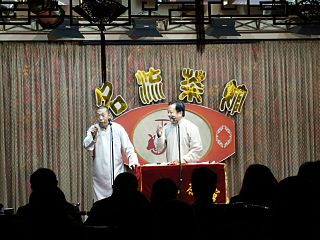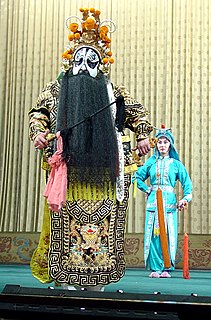
Chinese culture is one of the world's oldest cultures, originating thousands of years ago. The area in which the culture is dominant covers a large geographical region in East Asia with customs and traditions varying greatly between provinces, cities, and even towns as well. With China being one of the earliest ancient civilizations, Chinese culture is extremely diverse and varying, and it has a profound effect in the philosophy, virtue, etiquette and traditions of Asia to date.

Traditional Chinese opera, or Xiqu, is a popular form of drama and musical theatre in China with roots going back to the early periods in China. It is a composite performance art that is an amalgamation of various art forms that existed in ancient China, and evolved gradually over more than a thousand years, reaching its mature form in the 13th century during the Song dynasty (960–1279). Early forms of Chinese theater are simple, but over time they incorporated various art forms, such as music, song and dance, martial arts, acrobatics, costume and make-up art, as well as literary art forms to become traditional Chinese opera.

Cantonese opera is one of the major categories in Chinese opera, originating in southern China's Guangdong Province. It is popular in Guangdong, Guangxi, Hong Kong, Macau and among the Chinese community in Southeast Asia. Like all versions of Chinese opera, it is a traditional Chinese art form, involving music, singing, martial arts, acrobatics, and acting.

Sichuan University is a university in Chengdu, the capital of Sichuan Province, China. It has a long history and many predecessors, of which the earliest one was founded in 1740 with the origin in BCE 141. It was transformed to be a modern university in 1920s and the name National Sichuan University (國立四川大學) was adopted in 1931.

Qinqiang or Luantan is the representative folk Chinese opera of the northwest Province of Shaanxi, China, where it was called Qin thousands of years ago. Its melodies originated from rural areas of ancient Shaanxi and Gansu. The word itself means "the tune or sound of Qin."

Peking opera, or Beijing opera, is the most dominant form of Chinese opera which combines music, vocal performance, mime, dance and acrobatics. It arose in Beijing in the mid-Qing dynasty (1636–1912) and became fully developed and recognized by the mid-19th century. The form was extremely popular in the Qing court and has come to be regarded as one of the cultural treasures of China. Major performance troupes are based in Beijing, Tianjin and Shanghai. The art form is also preserved in Taiwan, where it is also known as Guójù. It has also spread to other regions such as the United States and Japan.
Four Great Characteristic Melodies in Chinese opera are Bangziqiang, Huangpiqiang, Kunqiang and Gaoqiang.

Sanxingdui is the name of an archaeological site and a major Bronze Age culture in modern Guanghan, Sichuan, China. Largely discovered in 1986, following a preliminary finding in 1929, archaeologists excavated remarkable artifacts that radiocarbon dating placed in the 12th–11th centuries BCE. The type site for the Sanxingdui culture that produced these artifacts, archeologists have identified the locale with the ancient kingdom of Shu. The artifacts are displayed in the Sanxingdui Museum located near the city of Guanghan.

Xiangsheng, also known as crosstalk, is a traditional Chinese comedic performing art, and one of China's most popular cultural elements. It is typically in the form of a duo dialogue between two performers, but much less often can also be a monologue by a solo performer, or even less frequently, a group act by multiple performers. The xiangsheng language, rich in puns and allusions, is delivered in a rapid, bantering style, typically in the Beijing dialect. The acts would sometimes include singing, Chinese rapping and musical instruments.

Great Shu called in retrospect Former Shu or occasionally Wang Shu (王蜀), was one of the Ten Kingdoms formed during the chaotic period between the rules of the Tang dynasty and the Song dynasty. It existed in 907–925 CE. It was the third state named "Shu" on the same territory, the second one had been Shu Han.

Sichuanese or Szechwanese (simplified Chinese: 四川话; traditional Chinese: 四川話; Sichuanese Pinyin: Si4cuan1hua4; pinyin: Sìchuānhuà; Wade–Giles: Szŭ4-ch'uan1-hua4), also called Sichuanese/Szechwanese Mandarin (simplified Chinese: 四川官话; traditional Chinese: 四川官話; pinyin: Sìchuān Guānhuà) is a branch of Southwestern Mandarin spoken mainly in Sichuan and Chongqing, which was part of Sichuan Province until 1997, and the adjacent regions of their neighboring provinces, such as Hubei, Guizhou, Yunnan, Hunan and Shaanxi. Although "Sichuanese" is often synonymous with the Chengdu-Chongqing dialect, there is still a great amount of diversity among the Sichuanese dialects, some of which are mutually unintelligible with each other. In addition, because Sichuanese is the lingua franca in Sichuan, Chongqing and part of Tibet, it is also used by many Tibetan, Yi, Qiang and other ethnic minority groups as a second language.
Gaojia opera or Ko-kah opera is a form of Chinese opera popular in Fujian province in the People's Republic of China. It is famous for its various chou (clown) roles. The form emerged at the end of the Ming Dynasty. It was originally an improvised form that was part of a religious parade. The performances from these parades developed into Songjiang drama, which told stories about the character Songjiang from the Chinese classic Water Margin and featured acrobatics and a relatively simple plot. In the middle of the Qing Dynasty, it absorbed the influences of Hui opera (徽戲), Beijing opera, and Yiyang music. All music accompanying Gaojia opera is in the style of southern China, and is also influenced by Liyuan opera.
In China, revolutionary opera refers to the model operas planned and engineered during the Cultural Revolution (1966–1976) by Jiang Qing, the wife of Chairman Mao Zedong. They were considered revolutionary and modern in terms of thematic and musical features when compared with traditional Chinese operas. Many of them were adapted to film.
Guanxiu was a celebrated Buddhist monk, painter, poet, and calligrapher. His greatest works date from the Five Dynasties and Ten Kingdoms period. The collapse of the central Tang government in 907, meant artists and craftsmen lost their most powerful patrons. The imperial tang court had inspired a golden age of literature and art at its apogee. The various provincial courts who claimed to represent a continuation of the tradition of Tang government also claimed continuity in the arts and culture. The state of the Former Shu had acted as the traditional western sanctuary ever since the Emperor Xuanzong had sought refuge there during the An Shi Rebellion in 755. By the collapse of the Tang Dynasty something like a miniature Tang court existed at Chengdu. Guanxiu arrived in chengdu in 901, and remained there until his death.

Korean revolutionary opera is a tradition of revolutionary opera in North Korea based on that of China during the Cultural Revolution. It is characterized by a highly melodramatic style and reoccurring themes of Korean nationalism and glorification of Juche, the Kim dynasty, and the working people, as well as a focus on socialist realist themes. Composers of North Korean revolutionary opera are employed by the North Korean government and the fundamental principles of North Korean revolutionary opera were dictated by Kim Jong-Il in his speech On the Art of Opera.
Chengdu–Mianyang–Leshan intercity railway(simplified Chinese: 成绵乐客运专线; traditional Chinese: 成綿樂客運專線; pinyin: Chéng-Mián-Lè Kèyùn Zhuānxiàn) is a higher-speed intercity railway in Sichuan Province that connects Mianyang, Chengdu, Deyang, Meishan, Emei and Leshan. The line is 314 km (195 mi) in length and can accommodate trains traveling at the speed of 200 km/h (124 mph). Construction began in 2008 and was completed on June 29, 2014. Revenue service began on December 20, 2014.

The Chengdu Huangcheng Mosque is a mosque in Qingyang District, Chengdu, Sichuan Province, China. It is the largest mosque in Sichuan.

The Jing is a role type in Chinese opera for "rough" or "mighty" male characters. In many genres, this role requires heavy face painting. As a result, it is also known as Hualian. However, not all characters with painted faces fall into this category, with Chou (clowns) being another major painted-face role type.




















